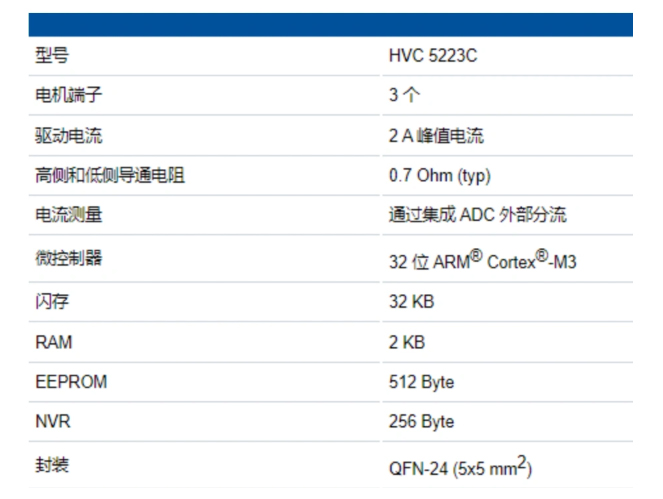TDK has developed a new embedded motor controller that can output 2 A peak current for driving brushless DC motors (BLDC) and brushless DC motors (BDC)
Embedded motor control technology aims to provide stronger performance and reliability for automotive and industrial application scenarios
Suitable for hybrid and electric vehicle heat exchange systems, automotive actuators, small fans and pumps, and passenger air conditioning systems
TDK Corporation is expanding its Micronas embedded motor controller series HVC and launching the HVC 5223C. This is a certified automotive grade first level product with a fully integrated motor controller that can drive small brushless (BDC) or brushless (BLDC) motors with a peak phase current of 2 A. The HVC 5223C adopts a compact 5x5 square millimeter 24 pin QFN package, which is functionally compatible with the HVC 5222C pins. The HVC 5222C has a peak current capacity of 1 A. The samples are now available for customer evaluation.

In addition to being able to drive 1 A or 2 A peak current, the HVC 5222C and HVC 5223C devices will also provide many motor specific analog and digital functions, such as phase comparators, virtual star points, and current detection amplifiers, to achieve sensorless control for a single brushless DC motor, or to drive two brushless motors and various other loads.
The HVC series, including HVC 4x and HVC 5x, has been expanded to seven fully integrated motor controllers with three to six motor outputs, capable of supporting peak currents from 500 mA to 2 A. All devices are equipped with 32-bit ARM ® Cortex ®- M3 CPU core and 32 KB or 64 KB flash options. In addition, all devices are equipped with 12 bit, 1 µ s ADC for various measurements, providing a wide range of options in application scenarios that require precise sensing. The device is also equipped with LIN transceivers and UART, using BSM methods for communication and automatic addressing, which increases their versatility in various applications.
All HVC equipment complies with the AEC-Q100 standard for automotive level temperature certification, and is a solution primarily aimed at compact automotive actuator applications for HEV/EV heat exchange systems** AEC-Q100 certification ensures that the HVC 5223C meets the highest quality and reliability standards, making it a trustworthy choice for automotive and industrial application scenarios.
Glossary
AEC-Q100: Automotive Application Qualification Standards
ADC: analog-to-digital converter
BDC: Brushed DC motor
BLDC: Brushless DC motor
BSM: Bus Shunting Method for LIN Automatic Addressing*
CPU: Central processing unit
Level 1: ambient temperature 125 ℃, working junction temperature 150 ℃
HVC: High voltage microcontroller
LIN: Local interconnection network for automotive applications
QFN: Four flat pinless packaging
UART: Universal asynchronous transceiver
Main application scenarios**
• Passenger air conditioning system, seats
Hybrid and electric vehicle heat exchange systems
• Automotive actuators
• Small fan and pump
Main data***

*IP prompt: If the LIN automatic addressing function is used, third-party permissions such as EP 1490 772 B should be considered.
**We do not declare that the target application of the product we mentioned is suitable for any purpose, as this must be checked at the system level.
***All operational parameters must be verified by the customer's technical experts for each application

